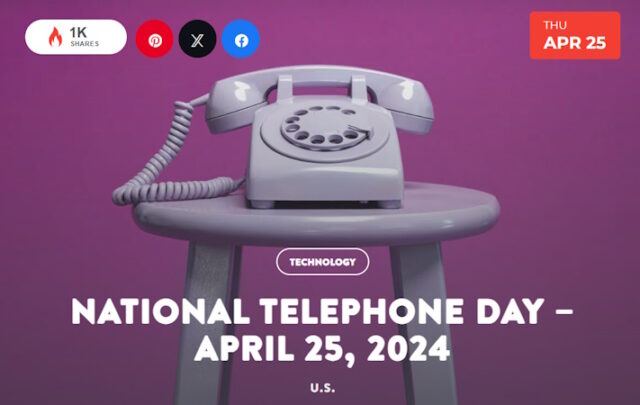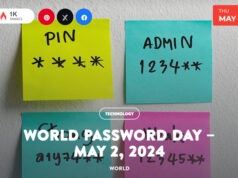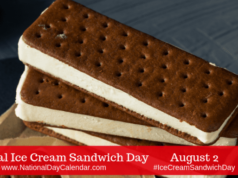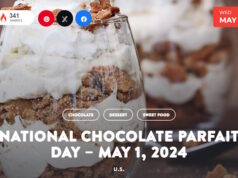
On April 25, we observe National Telephone Day. Around the world, there are 10.82 billion mobile phones. And while some predicted the landline to be obsolete by 2020, there are still about 931 million landlines around the world.
- 1667 – Robert Hooke, a British physicist, invents the ‘tin can telephone,’ also known as the ‘lovers’ phone.’
- 1828 – The Word “Telephone” Was Used Before The Telephone Existed. The term actually predated the device as we know it. The word “telephone” was first used in 1828 by a man named Francois Sudre to describe his invention, which was a musical signaling device. Later on, the term was also applied to the phone as we know it.
- 1876 – Inventor Elisha Gray files a patent for the telephone within hours of Alexander Graham Bell, but Bell’s patent gets approved first.
- 1876 – a cash-strapped Alexander Graham Bell, inventor of the first successful telephone offered to sell his telephone patent to Western Union for $100,000. They declined.
- 1876 – By May, Bell and his team stood prepared for a public demonstration. And there would be no better place than the grand stage of the World’s Fair in Philadelphia. On May 10, 1876, in a crowded Machinery Hall, a man’s voice transmitted from a small horn and carried out through a speaker to the audience.
- 1877 – One year later, the White House installed its first phone. The telephone revolution began.
- 1877 – Bell Telephone Company was founded on July 9, 1877, and they installed the first public telephone lines from Boston to Sommerville, Massachusetts, the same year.
- 1878 – The District Telephone Company of New Haven was established on January 28, 1878, becoming the first commercial telephone exchange in the world.
- 1879 – Initially, subscribers to the telephone service were listed by name, and no numbers were assigned to them. People had to provide names to telephone operators to connect to them. The first telephone numbers were used in 1879 in Massachusetts.
- 1880 – On June 3, 1880, Alexander Graham Bell transmitted the first wireless telephone message on his “photophone.” The device allowed for the transmission of sound on a beam of light, without wires. This technology was a rudimentary version of what we know as fiber optics today.
- 1904 – The French Phone was developed by the Bell company. This had the transmitter and receiver in a simple handset in 1904.
- 1908 – The first U.S. patent for a mobile phone was issued in 1908 in Kentucky to Nathan B. Stubblefield. The patent was for a radiotelephone.
- 1910 – New York Telephone had 6,000 women telephone operators by 1910.
- 1915 – Bell, located in New York, calls Thomas Watson in San Francisco, probably to argue about who was paying cheaper rent (history cannot confirm)
- 1967 – In May of 1967, the 100 million telephone line was installed in the United States.
- 1967 – On May 11th, governors and dignitaries for U.S. territories joined President Lyndon Johnson on the largest conference call ever held up to that date.
- 1983 – The first mobile phone was born in 1983, and it was called the DynaTAC 8000x. It was made by Motorola and looked like other telephones from its time, except that it didn’t have wires! It took 10 hours to charge fully, and you could use it only for 30 minutes.
- 1992 – The first smartphone was created in 1992 and made available in 1994. It was created by IBM and the model was known as the Simon Personal Communicator.
- 2019 – As of 2019, statistics reveal that there are around 8 billion mobile phones, compared to 7 billion people alive on Earth.
- The correct answer to a trivia question like “Who invented the telephone?” is the name on the patent. In this case, the whole world knows the answer is Alexander Graham Bell. Had his attorney been delayed by foul weather or poor planning, the answer may have been a different name.
- Three days after the patent was approved, Bell spoke the first words by telephone to his assistant. “Mr. Watson, come here! I want to see you!”
- “Ahoy” was the original telephone greeting. Alexander Graham Bell suggested ‘ahoy’ (as used in ships), but was later superseded by Thomas Edison, who suggested ‘hello’ instead.
- According to a survey, 47 percent of all water-damaged mobile phones in the UK have been dropped in the toilet bowl.
- In the early days, telephone wires were ranked according to how tasty they were to mice and rats.
- Mark Twain was one of the first to have a phone in his home.
- Frigensophobia is the fear that using your mobile is damaging your brain.
- Addiction to mobile phones is called nomophobia.
- Payphones are still used by five percent of the population, at least once per year.
- The first phonebook in history was just one page long. The first telephone directory, consisting of a single piece of cardboard, was issued on 21 February 1878; it listed 50 individuals, businesses, and other offices in New Haven, Connecticut that had telephones. The directory was not alphabetized and no numbers were associated with the people included in it.
- Mobile phones have 18 times more bacteria than toilet handles.
- The phrase “to put someone on hold” was named after Alexander and his assistant Mr. Watson, when Bell handed Watson the phone and said, “Here, hold this.”
- 41% of people under 25 hate it when you don’t pick up the phone after you have just texted them.
- The automatic dialing system was invented by Almon Brown Strowger. Strowger was an undertaker who, like other subscribers, used the services of telephone operators who connected calls to and from his place of business. One of the telephone operators was a competitor’s wife. Strowger believed that she sent calls that were supposed to be for his business to her husband instead.
- Do payphones still exist? Yes. However, the number of payphones began declining in the mid-1990s. If you’re looking for a payphone, some cities and states have payphone maps. You can also look in public places like federal offices, libraries, transportation hubs, large shopping centers, and gas stations.
Sources
Telephone Interpreting Service












